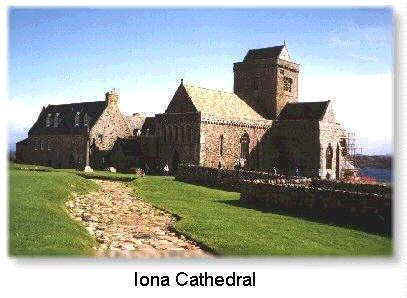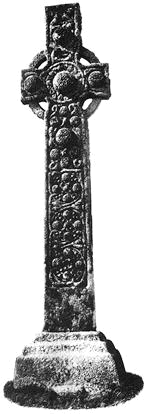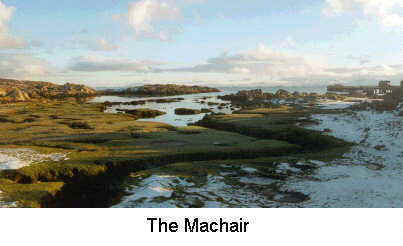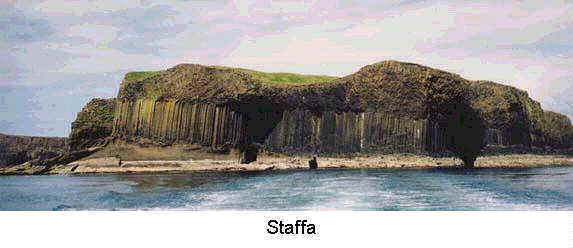IONA PILGRIMAGE
A prayer of St Columba
My dearest Lord,
Be thou a bright flame before me, Be thou a
guiding star above me,
Be thou a smooth path beneath me, Be thou a
kindly shepherd behind me,
Today and evermore.
 Getting
there was quite an undertaking – two trains, two ferries and a coach! I left
Preston at 8.45 am and nine and a half hours later I was towing my suitcase up
the slipway from the ferry in the early evening sunshine – journey’s end –
Columba’s isle – Iona!
Getting
there was quite an undertaking – two trains, two ferries and a coach! I left
Preston at 8.45 am and nine and a half hours later I was towing my suitcase up
the slipway from the ferry in the early evening sunshine – journey’s end –
Columba’s isle – Iona!
The following evening, after a day spent among
the birds of the Treshnish Islands, I walked up to the Abbey for the evening
service. Arriving early, I passed the time reading the Iona Community Worship
Book and here came across the details of the Iona Pilgrimage. This takes place
once a week and is led by members of the Iona Community, taking the form of a
trek around the island visiting religious sites and places associated with Saint
Columba.
Next morning, in glorious sunshine, we assembled
at the Abbey at the foot of St Martin’s Cross, one of Iona’s High Crosses
and still standing where it was first erected over a thousand years ago. It is
dedicated to St Martin of Tours who from the earliest times had been revered by
succeeding monastic communities on the island. The leaders of our pilgrimage,
Joss and Brian, greeted us and outlined the
nature of our journey. It would cover about six and a half miles, over a
moorland and down to the sea, stopping at selected sites for prayers, songs and
reflections. We were encouraged to mix and share our experiences. There were
about sixty of us: the majority were staying at the Abbey (temporary members of
the Community). I counted at least ten different nationalities – we were,
indeed international as well as ecumenical.
Joss began our pilgrimage with the prayer of St
Columba. Our first port of call was at the nearby ruins of the Augustinian
nunnery. These are very beautiful - the stone is a mixture of pink granite,
yellow sandstone and grey flagstone and in the sunshine it sparkles. The nunnery
was founded by Reginald, the son of the Scottish hero Somerled, founder of the
dynasty known as the Lords of the Isles and the scourge of the Norsemen… Built
in the 1200’s the first prioress was Reginald’s sister Beathag. Here we
reflected upon the role of women in the Christian church down the years.
We moved on out of the village taking the road
leading to the crossroads known as the Four Roads. We stopped and looked down
across the fields to the War Memorial which stands overlooking a peaceful
stretch of golden sand. This has long been associated with death and is called
Port Nam Mairtear (Martyrs’ Bay). Here, it is believed, was once a massacre of
monks from the Abbey during the time of the Viking raids. At the head of the bay
is a grassy mound, An Ealadh, and here were rested the coffins of kings and
chieftains on their journey along the Street of the Dead to the Reilig Odhrain
(the abbey’s graveyard). After prayers for those who have suffered as a result
of warfare, we were asked to continue on in silence and reflect upon man’s
inhumanity.
Our third stop was at the crossroads (The Four
Roads) and Brian told us that from hence the way would be harder as we took to
the moorland. We walked on along a narrow track that twisted through outcrops
towards the southern end of the island. The track wound in and out of small
hillocks among wild flowers. Bees hummed, birds sang, and on a nearby mound we
heard, and later spotted, a cuckoo. We turned south east towards the abandoned
marble quarry which is tucked in among the cliffs. From here came the huge piece
of green-veined marble that became the altar table in the abbey. Returning to
the main track we then continued our way to the sea – to the Bay of the
Coracle. Here Columba landed with his followers in their coracle in 563, which
must have been no mean feat. Later in the week I was told by a boatman that this
bay is the most dangerous landing site in Iona. On the beach are several cairns
of stones, some of which are very old. We were asked to pick up two pebbles from
the beach and to place one on a cairn as an act of devotion and to carry the
other home in memory of the pilgrimage and a symbol of our lives’ journeys
from that point on. We then retired to a small hillock above the bay for a short
lunch stop and prayers before retracing our steps back across the moorland to
Loch Staonaig, once the main supply of fresh water to the island. Latterly,
owing to increased usage, water has to be pumped over from Mull. Joss reminded
us that water is one of the most precious of God’s resources.
 Our
next destination was the Machair.This is the Gaelic name for the beautiful green
turf, dotted with wild flowers, which stretches down to the sand and to the Bay
at the Back of the Ocean (a lovely name for a lovely place). By now we were
beginning to feel weary and the Iona Community performed a truly Christian act.
Through the gate, onto the Machair, came their van and from it cups of tea and
flapjack were distributed. After our prayers and further reflections, those
pilgrims who were finding the going too hard were offered a lift back – an
offer which was politely declined by all! It was then onward and upward –
across the machair, past the intimidating bulk of Dun Bhuirg(site of an Iron Age
hill fort) and into the hilly country. Our first stop was at the site of an old
"bee-hive" hut, which was believed to have been either a hermit’s
cell or a place to which the monks withdrew for prayer and solitude.
Our
next destination was the Machair.This is the Gaelic name for the beautiful green
turf, dotted with wild flowers, which stretches down to the sand and to the Bay
at the Back of the Ocean (a lovely name for a lovely place). By now we were
beginning to feel weary and the Iona Community performed a truly Christian act.
Through the gate, onto the Machair, came their van and from it cups of tea and
flapjack were distributed. After our prayers and further reflections, those
pilgrims who were finding the going too hard were offered a lift back – an
offer which was politely declined by all! It was then onward and upward –
across the machair, past the intimidating bulk of Dun Bhuirg(site of an Iron Age
hill fort) and into the hilly country. Our first stop was at the site of an old
"bee-hive" hut, which was believed to have been either a hermit’s
cell or a place to which the monks withdrew for prayer and solitude.
We then climbed up to the highest
part of the island - Dun I. No great height, really, but at the end of a very
hot day and a six miles walk, a small challenge, nevertheless. From this spot St
Columba and thousands of pilgrims to the island down the years, have looked out
across the sea to the island of Tiree (the land below the waves) and Coll and to
Barra and South Uist. Northwards lie the Treshnish Isles an d
Staffa and Rhum and Eigg, and on a very clear day the Cuillins of Skye can be
seen. To the south-east lie Colonsay and Oransay and beyond the hills of Jura
and Islay; closer to hand the island of Mull. Our view was a little hazy so we
couldn’t see and identify all the islands but the sea below us was that
mixture of marble-white, through aquamarine, to cobolt blue that is the colour
of Hebridean waters. After more prayers we came down onto the road and by this
time we were all flagging – even the young!
d
Staffa and Rhum and Eigg, and on a very clear day the Cuillins of Skye can be
seen. To the south-east lie Colonsay and Oransay and beyond the hills of Jura
and Islay; closer to hand the island of Mull. Our view was a little hazy so we
couldn’t see and identify all the islands but the sea below us was that
mixture of marble-white, through aquamarine, to cobolt blue that is the colour
of Hebridean waters. After more prayers we came down onto the road and by this
time we were all flagging – even the young!
Our final destination was back at the Abbey. We
filed into the Reilig Oran, the graveyard of the abbey, named for one of Columba’s
earliest followers, so it is said. In the graveyard stands a small chapel, St
Oran’s Chapel. It is the oldest ecclesiastical building and dates back to the
twelfth century. We crowded in through the narrow doorway. Inside the chapel it
was dark and cool and still. Here, we held our final act of worship – a song,
some prayers and Joss asked us all to reflect on what we had experienced and
thanked us for our company. I found myself at the back, pressed against one of
the standing grave slabs that lined the walls. It was a very welcome support and
I trusted that the long dead chieftain or king (John, Lord of the Isles, perhaps
– or even Macbeth, who knows?) would not begrudge a weary pilgrim her ease. At
the end of the short service we returned to the sunshine, moving rather slowly
now. We said our farewells and went our separate ways – the majority back to
the Community but some of us to our hotels and B & B’s and one couple took
the ferry back to Mull.
A few days later I left Iona and after visiting
two more islands – Kerrera and Lesmore, I came home, bringing with me, as well
as the pebble from the Bay of the Coracle, some wonderful memories – of the
pilgrimage, the people – and the puffins? Indeed, Columba’s isle is truly
"God’s own country".
Barbara Hothersall
 Getting
there was quite an undertaking – two trains, two ferries and a coach! I left
Preston at 8.45 am and nine and a half hours later I was towing my suitcase up
the slipway from the ferry in the early evening sunshine – journey’s end –
Columba’s isle – Iona!
Getting
there was quite an undertaking – two trains, two ferries and a coach! I left
Preston at 8.45 am and nine and a half hours later I was towing my suitcase up
the slipway from the ferry in the early evening sunshine – journey’s end –
Columba’s isle – Iona!
 Our
next destination was the Machair.This is the Gaelic name for the beautiful green
turf, dotted with wild flowers, which stretches down to the sand and to the Bay
at the Back of the Ocean (a lovely name for a lovely place). By now we were
beginning to feel weary and the Iona Community performed a truly Christian act.
Through the gate, onto the Machair, came their van and from it cups of tea and
flapjack were distributed. After our prayers and further reflections, those
pilgrims who were finding the going too hard were offered a lift back – an
offer which was politely declined by all! It was then onward and upward –
across the machair, past the intimidating bulk of Dun Bhuirg(site of an Iron Age
hill fort) and into the hilly country. Our first stop was at the site of an old
"bee-hive" hut, which was believed to have been either a hermit’s
cell or a place to which the monks withdrew for prayer and solitude.
Our
next destination was the Machair.This is the Gaelic name for the beautiful green
turf, dotted with wild flowers, which stretches down to the sand and to the Bay
at the Back of the Ocean (a lovely name for a lovely place). By now we were
beginning to feel weary and the Iona Community performed a truly Christian act.
Through the gate, onto the Machair, came their van and from it cups of tea and
flapjack were distributed. After our prayers and further reflections, those
pilgrims who were finding the going too hard were offered a lift back – an
offer which was politely declined by all! It was then onward and upward –
across the machair, past the intimidating bulk of Dun Bhuirg(site of an Iron Age
hill fort) and into the hilly country. Our first stop was at the site of an old
"bee-hive" hut, which was believed to have been either a hermit’s
cell or a place to which the monks withdrew for prayer and solitude. d
Staffa and Rhum and Eigg, and on a very clear day the Cuillins of Skye can be
seen. To the south-east lie Colonsay and Oransay and beyond the hills of Jura
and Islay; closer to hand the island of Mull. Our view was a little hazy so we
couldn’t see and identify all the islands but the sea below us was that
mixture of marble-white, through aquamarine, to cobolt blue that is the colour
of Hebridean waters. After more prayers we came down onto the road and by this
time we were all flagging – even the young!
d
Staffa and Rhum and Eigg, and on a very clear day the Cuillins of Skye can be
seen. To the south-east lie Colonsay and Oransay and beyond the hills of Jura
and Islay; closer to hand the island of Mull. Our view was a little hazy so we
couldn’t see and identify all the islands but the sea below us was that
mixture of marble-white, through aquamarine, to cobolt blue that is the colour
of Hebridean waters. After more prayers we came down onto the road and by this
time we were all flagging – even the young!